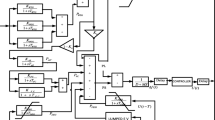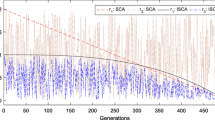Abstract
The research paper presents implementation of a fuzzy rule and membership function-based fuzzy-aided PID controller for automatic generation control (AGC) in multiarea nonlinear power system. At the initial stage of this proposed work, a three-area nine-unit installed interconnected network is considered for developing different dynamic responses in response to AGC analysis. A modified approach named modified sine cosine algorithm (M-SCA) is proposed for tuning the gain parameters of the above-proposed fuzzy controller to produce close optimum gain values. The proposed modified algorithm is developed from its original sine cosine algorithm by improving and updating few equations which is capable of making the balance between exploration and exploitation levels of this algorithm and improving the updating quality of iteration. To impose supremacy of M-SCA technique, it is examined through convergence curves and its performance is compared with host sine cosine algorithm, genetic algorithm, and particle swarm optimization algorithm. For controller supremacy analysis, the performance of the proposed fuzzy-aided PID controller is compared with conventional I, PI, and PID controllers, and it has been revealed that proposed M-SCA-tuned fuzzy-aided PID controller exhibits better performances through different deviated responses for AGC analysis. To demonstrate most standard and supremacy of proposed approaches, finally these are tested through a five-area ten-unit system considering some physical nonlinear constraints like generation rate constraint, governor dead band, boiler dynamics and time delay. At the final observation level, the proposed fuzzy controller has gone through different sensitivity analyses with variation of different system parametric conditions and different load conditions.












Similar content being viewed by others
References
Arya Y, Kumar N (2017) Design and analysis of BFOA-optimized fuzzy PI/PID controller for AGC of multi-area traditional/restructured electrical power systems. Soft Comput 21(21):6435–6452
Dash P, Saikia LC, Sinha N (2014) Comparison of performances of several Cuckoo search algorithm based 2DOF controllers in AGC of multi-area thermal system. Int J Electr Power Energy Syst 55:429–436
Debbarma s, Saikia LC (2012) Bacterial foraging based FOPID controller in AGC of an interconnected two-area reheat thermal system under deregulated environment. In: International conference on advances in engineering, science and management (ICAESM), IEEE, pp 303–308
Debbarma S, Saikia LC, Sinha N (2013) AGC of a multi-area thermal system under deregulated environment using a non-integer controller. Electric Power Syst Res 95:175–183
Du X, Li P (2006) Fuzzy logic control optimal realization using GA for multi-area AGC systems. Int J Inf Technol 12(7):63–72
Elgerd OI (2007) Electric energy systems theory: an introduction, vol 2, 2nd edn. Tata McGraw-Hill Publishing Company Ltd., New Delhi
Kundur P (2009) Power system stability and control. Tata McGraw-Hill, New Delhi
Mirjalili S (2016) SCA: a sine cosine algorithm for solving optimization problems. Knowl-Based Syst 96:120–133
Mohanty B (2015) TLBO optimized sliding mode controller for multi-area multi-source nonlinear interconnected AGC system. Int J Electr Power Energy Syst 73:872–881
Panda S, Yegireddy NK (2013) Automatic generation control of multi-area power system using multi-objective non-dominated sorting genetic algorithm-II. Int J Electr Power Energy Syst 53:54–63
Rashedi E, Nezamabadi-Pour H, Saryazdi S (2009) GSA: a gravitational search algorithm. Inf Sci 179:2232–2248
Roy A, Dutta S, Roy PK (2015) Load frequency control of interconnected power system using teaching learning based optimization. Int J Energy Optim Eng (IJEOE) 4(1):102–117
Sahu RK, Panda S, Rout UK (2013) DE optimized parallel 2-DOF PID controller for load frequency control of power system with governor dead-band nonlinearity. Int J Electr Power Energy Syst 49:19–33
Sahu RK, Panda S, Yegireddy NK (2014) A novel hybrid DEPS optimized fuzzy PI/PID controller for load frequency control of multi-area interconnected power systems. J Process Control 24:1596–1608
Sahu RK, Panda S, Sekhar GC (2015a) A novel hybrid PSO-PS optimized fuzzy PI controller for AGC in multi area interconnected power systems. Int J Electr Power Energy Syst 64:880–893
Sahu BK, Pati S, Mohanty PK, Panda S (2015b) Teaching–learning based optimization algorithm based fuzzy-PID controller for automatic generation control of multi-area power system. Appl Soft Comput 27:240–249
Sahu PC, Prusty RC, Panda S (2017a) MFO algorithm based fuzzy-PID controller in automatic generation control of multi-area system. In: 2017 international conference on circuit, power and computing technologies (ICCPCT), IEEE, pp 1–6
Sahu PC, Prusty RC, Panda S (2017b) ALO optimized NCTF controller in multi area AGC system integrated with WECS based DFIG system. In: 2017 International conference on circuit, power and computing technologies (ICCPCT). IEEE, pp 1–6
Sahu PC, Mishra S, Prusty RC, Panda S (2018) Improved-salp swarm optimized type-II fuzzy controller in load frequency control of multi area islanded AC microgrid. Sustain Energy Grids Netw 16:380–392
Sahu PC, Prusty RC, Panda S (2019a) A gray wolf optimized FPD plus (1+ PI) multistage controller for AGC of multisource non-linear power system. World J Eng. https://doi.org/10.1108/WJE-05-2018-0154
Sahu PC, Prusty RC (2019b) Stability analysis in RECS integrated multi-area AGC system with modified-SOS optimized fuzzy controller. Recent Adv Electr Electron Eng (Formerly Recent Pat Electr Electron Eng) 12(6):532–542
Sahu PC, Prusty RC, Panda S (2019c) Approaching hybridized GWO-SCA based type-II fuzzy controller in AGC of diverse energy source multi area power system. J King Saud Univ-Eng Sci. https://doi.org/10.1016/j.jksues.2019.01.004
Saikia LC, Debbarma S (2011) Application of a non-integer order controller in AGC of a two area thermal system under deregulated environment: a preliminary study
Shabani H, Vahidi B, Ebrahimpour M (2013) A robust PID controller based on imperialist competitive algorithm for load-frequency control of power systems. ISA Trans 52(1):88–95
Sinha SK, Patel RN, Prasad R (2010) Application of GA and PSO tuned fuzzy controller for AGC of three area thermal-thermal-hydro power system. Int J Comput Theory Eng 2(2):238
Storn R, Price K (1997) Differential evolution–a simple and efficient heuristic for global optimization over continuous spaces. J Glob Optim 11:341–359
Funding
No fund has been sanctioned or sponsored for this research work.
Author information
Authors and Affiliations
Corresponding author
Ethics declarations
Conflict of interest
All authors associated for this research article has not any conflict of interest.
Ethical approval
This article does not contain any studies with human participants or animals performed by any of the authors.
Additional information
Communicated by V. Loia.
Publisher's Note
Springer Nature remains neutral with regard to jurisdictional claims in published maps and institutional affiliations.
Appendices
Appendix A
Power system parameters
\( K_{{ps_{i} }} \) = Power system gain = 120 Hz/pu MW; \( T_{{ps_{i} }} \) = Time constant of power system = 20 s; \( B_{i} \) = Frequency bias parameter = 0.425 pu MW/Hz.
Thermal power station
\( T_{{G_{i} }} \) = Time constant of governor = 0.08 s; \( K_{{r_{i} }} \) = Coefficient of reheat turbine = 0.333; \( T_{{r_{i} }} \) = Reheat time constant = 10 s; \( T_{{T_{i} }} \) = Time constant of turbine = 0.3 s; \( R_{i} \) = 2.4 Hz/pu MW.
Boiler dynamics parameters
\( K_{1} \) = 0.85; \( K_{2} \) = 0.095; \( K_{3} \) = 0.92; \( K_{1B} \) = 0.03; \( T_{1B} \) = 26 s; \( T_{RB} \) = 69; \( C_{B} \) = 200; \( T_{D} \) = 0; TF= 10.
Hydropower station
\( T_{{g_{i} }} \) = Governor time constant = 0.041 s; \( T_{1} \) = Speed governor reset time = 0.5135; \( T_{2} \) = Transient droop time constant = 10 s; \( T_{W} \) = Water time constant = 1 s; \( R_{i} \) = 2.4 Hz/pu MW.
Wind power station
\( K_{2} \) = Coefficient of hydraulic pitch actuator = 1.25; \( T_{{P_{2} }} \) = Time constant of hydraulic pitch actuator = 0.041 s; \( T_{{P_{1} }} \) = 0.60 s; \( K_{4} \) = Coefficient of data fit-pitch response = 1.40; \( R_{i} \) = 2.4 Hz/pu MW.
Diesel power station
\( K_{Diesei} \) = 16.5 = Coefficient of diesel power system; \( R_{i} \) = = 2.4 Hz/pu MW (Regulation).
Gas power station
\( b_{i} \) = Valve position constant = 0.05; \( c_{i} \) = Valve position constant = 1; \( X_{i} \) = Speed governor lead time = 0.6 s; \( Y_{i} \) = Lag time constant = 1 s; \( T_{{CR_{i} }} \) = Time delay of Combustion reaction = 0.3 s; \( T_{{F_{i} }} \) = Time constant of fuel = 0.23 s; \( T_{{CD_{i} }} \) = Time constant of compressor discharge = 0.2 s; Ri = 2.4 Hz/pu MW.(Regulation).
Appendix B
Thermal system: Tg = 0.08; Tt = 0.3; Kr = 0.333; Tr= 10. PT = 0.5; hydro system: TH = 48.7; T1 = 0.513; T2 = 10; TW = 1; PH= 0.5; wind system: TP1 = 0.6; TP2 = 0.041; K4 = 1.4; PW = 0.124. Gas system: c1 = 0.049; b1 = 1; X1 = 0.06; Y1 = 1.1; TCR1 = 0.01; TF1 = 0.239; TCD1 = 0.2; PG = 0.125; diesel plant: Kdiesel = 16.5; PD= 0.125; R = 2.4.
Rights and permissions
About this article
Cite this article
Sahu, P.C., Prusty, R.C. & Sahoo, B.K. Modified sine cosine algorithm-based fuzzy-aided PID controller for automatic generation control of multiarea power systems. Soft Comput 24, 12919–12936 (2020). https://doi.org/10.1007/s00500-020-04716-y
Published:
Issue Date:
DOI: https://doi.org/10.1007/s00500-020-04716-y




